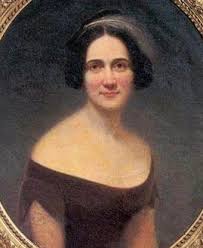“What a dear, delightful place is Charleston,” proclaimed Mary Chesnut, in March 1861. Mary loved the nightly dinners and dances while her husband was a delegate to the secession convention. South Carolina became the first state to secede from the U.S.
Mary Boykin Chesnut was born into a South Carolina family that owned plantations in South Carolina and Mississippi. Her father was a prominent Nullifier. Nullifiers argue that the Constitution’s 10th Amendment reserves all powers to the states unless specifically assigned to the federal government; and therefore federal laws don’t apply to a state without the state’s consent.
In the 19th century, Southern states passed laws nullifying federal laws meant to abolish slavery. Nullification regained popularity 150 years later when southern states, including Tennessee, voted to nullify some federal laws enacted during President Barak Obama’s administration.
Mary’s father died when she was 15 years old and her mother spent years settling his bankrupt estate. At the age of 18, Mary married James Chesnut, heir to one of the largest plantation owners in South Carolina. James was considered a political moderate who struggled to find a compromise that would hold the country together. After concluding that wasn’t possible, he resigned his U.S. Senate seat and was elected to the Charleston secession convention.
After the secession vote, Mary stayed in Charleston enjoying the parties while James left for a series of government jobs. As a result, Mary witnessed the attack on Ft. Sumter by Confederates troops under P.T.G. Beauregard. She joined other women standing in the streets or perched on rooftops to watch the cannon fire directed at the fort. On April 15, 1861, Ft. Sumter surrendered. Mary wrote, “I did not know that one could live such days of excitement”.
Mary witnessed many of the key events of the Civil War because she traveled frequently to be close to James. Luckily for us, she wrote a journal full of stories about the political and social leaders of the Confederacy, including her close friend Varina Davis, wife of Jefferson Davis.
She could be quite vain when describing the flattery showered on her because she knew she wasn’t a beauty. Her quick wit made her a high society favorite. She also loved to flirt, making James jealous. She recognized that the attention she received was an attempt to gain favor with her well-connected husband.
James served the Confederacy as an army officer and a government official. He could have risen higher if his personal honor code, which Mary described as “too high South Carolina,” had not prohibited asking for a job. Mary was often frustrated by his seeming lack of ambition.
When the war ended, Mary and James returned to their plantation, Mulberry, near Camden, South Carolina. They found a smoldering ruin of pillaged buildings and 100 bales of burnt cotton. Without the cotton, they had no money for rebuilding. For months their only income came from Molly, a former slave and Mary’s personal maid, who sold butter and eggs.
In 1866, Mary’s father-in-law died and James inherited Mulberry and several other plantations. However, the will required James to settle all his father’s debts before taking a penny of income from the estate and without selling any of the land to pay off the debts. James was also obligated to support a number of indigent female relatives.
Mary and James never recovered financially from the devastation of the Civil War and his father’s bankrupt estate. At James’ death in 1885, Mary had to fight to inherit anything from his bankrupt estate. Mary Chestnut died in 1886, an indomitable southern belle to her last breath.
Mary Chestnut’s journals have been edited and published several times. The most authoritative version is Mary Chestnut’s War, edited by C. Vann Woodward (1981). Every amateur and professional historian counts this book as one of the most important eye witness accounts of the Civil War South.
Want to receive this blog straight to your inbox? Sign up for my mailing list.




